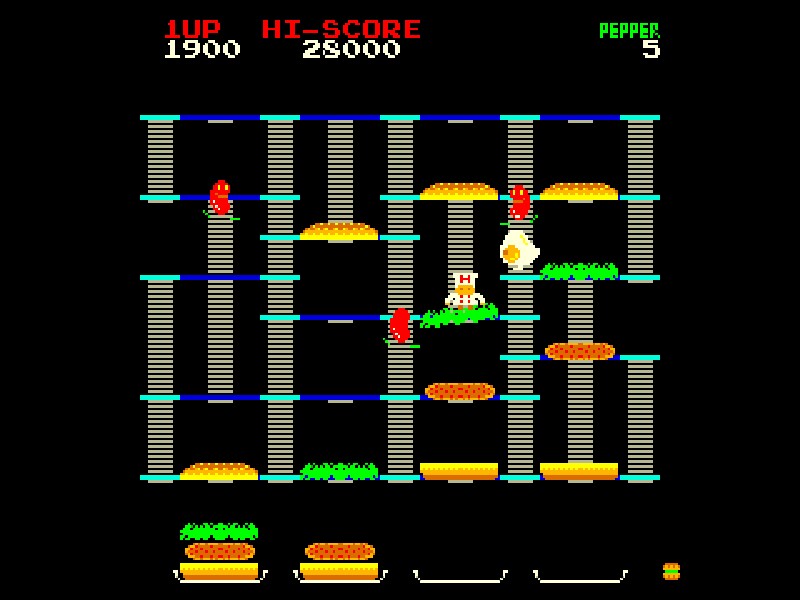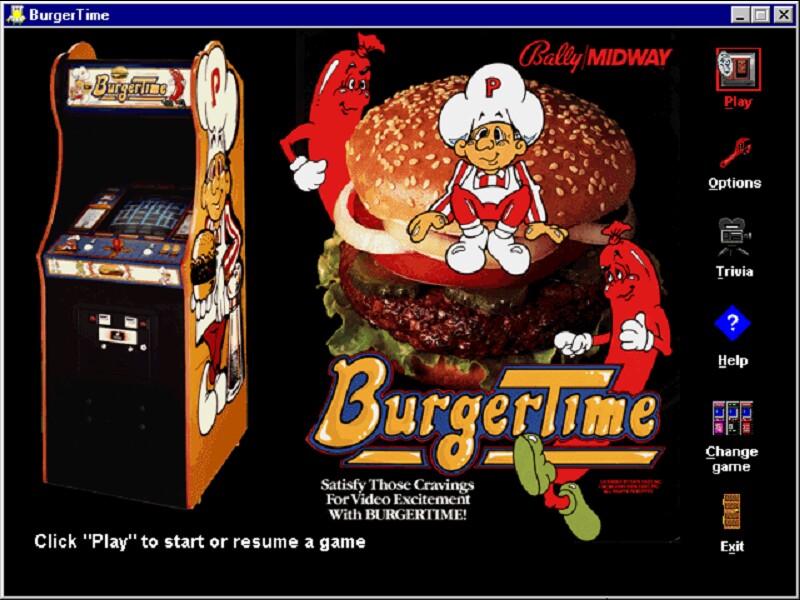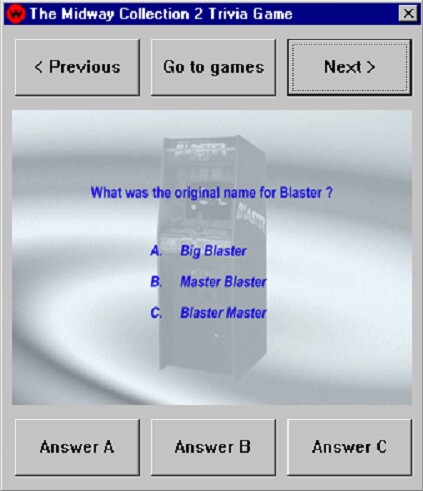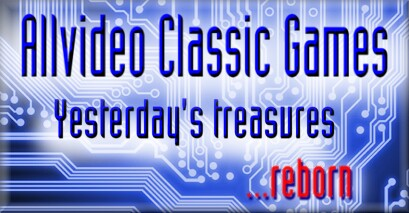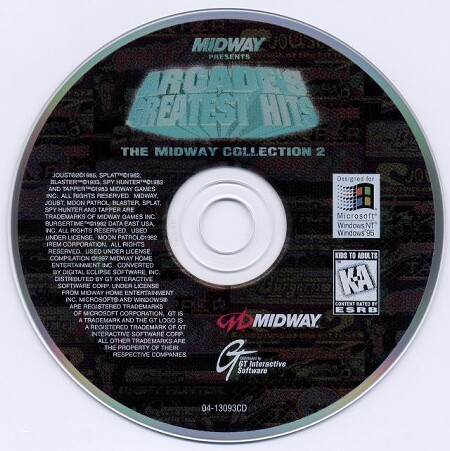
Actual Game
The Midway Collection
|
The Game
Arcade’s Greatest Hits: The Midway Collection 2 is the proper sequel to the first compilation in this retro series. Williams and Midway had been one and the same for awhile, and sometime after the release of the original collection, the company switched its name. That’s the reason for the name of this disc. Whatever you want to call it, it’s an interesting collection of some genuine classics from the early 80s, accompanied by a few lesser-known titles from the Williams/Midway catalog. Featured here are Burgertime, Moon Patrol, Spy Hunter, Blaster, Joust 2: Survival of the Fittest, Splat!, and Root Beer Tapper. Overall, it’s a solid package for retro enthusiasts.
For The Midway Collection 2, the designers took a novel approach to this background material by presenting it through a trivia game show. The questions are multiple-choice, and getting the right answer will bring up an interview segment with the programmer/s of the game. There’s no score-keeping, but wrong answers are usually accompanied by some humorous quips from the programmers. It’s a great idea, and it’s put together very nicely.
Blaster
The only place I ever saw Blaster was on the cover of Joystik magazine, and I thought it looked pretty cool. This game never had a chance at commercial success, however, because the game was developed on the eve of the video game crash, so it didn’t get much in the way of distribution. That’s an absolute shame, as Blaster is an excellent game that really was ahead of its time. Blaster is a first-person space shooter that picks up where Robotron: 2084 left off: the human race has been defeated by the merciless Robotrons, and it is up to you to find a new home, a paradise that is rumored to exist some 20 million light years away. In between Earth and Paradise are a whole bunch of robots, spaceships, and lots of other stuff that need to be blasted (they’re trying to do the same to you, of course). Keeping in mind the technical limitations of the time, Blaster is quite a feat of programming. This game uses sprites instead of vector graphics, so 3D effects weren’t as easy to produce. The game moves at a quick pace, and the action can get very intense, very quickly, which is just the way it should be in this sort of game. As with Robotron: 2084, the setup for Blaster is simple: blast and thrust are the only buttons, and flying is restricted to the bounds of an invisible space corridor. The nuclear family has been replaced by floating spacemen, which can be recovered for points just by flying into them. Considering its time of release, the graphics and sound in Blaster are exceptional, and the control is quite good. While you can reach Paradise on the 20th level, there is no ending to Blaster, and the levels will just cycle around, getting harder, naturally. Of course, if you’re good enough to reach Paradise, you’re in for a nice bonus. If any game deserves the title “lost classic,” it’s Blaster. It deserved a better fate.
Burgertime
I’m not sure why, but this game didn’t seem all that strange to me when I played it in the arcades, but looking back at it now, this is some twisted stuff. As Chef Peter Pepper, your job is to walk over gigantic hamburger ingredients littered across mazes, causing them to drop down several floors to the platters below. Complicating matters are several enemies chasing you: Mr. Hot Dog, Mr. Egg, and Mr. Pickle. Your only weapon is a limited number of pepper shakings, which will only stun your nemeses. Squashing enemies under hamburger parts will gain you points and temporarily remove the baddies from the screen. The best means of sidelining your enemies is to lure them onto hamburger parts just before you finish walking on them, causing a chain reaction of ingredient drops. That is just whacked. While the game doesn’t exactly make much sense, Burgertime is still an addictive game to play. Just don’t try to figure out why hot dogs and eggs, which have seemingly nothing to do with hamburgers, are trying to kill you.
Joust 2: Survival of the Fittest
Here’s another game that didn’t have much of a chance in the arcades, due to its untimely release. I actually did get to play this in an arcade way back when, and I didn’t really know what to think of it. Joust 2 is superior to its predecessor in terms of graphics and sound, but the gameplay isn’t quite on the same level. The rules are pretty much unchanged from the first: you need to be higher than your opponent when you collide, and buzzards can only be killed by lancing them in the mouth. There are a bunch of new enemies to deal with, including tiny bats and a mechanical buzzard that drops eggs and crystals that produce more enemies. There are a ton of new boards to play on (I counted 40 different ones), and a lot of them have extra hazards such as lightning and piledrivers. What this all adds up to is that Joust 2 is one tough game, and the only new power you’ve got, the Pegasus, isn’t too helpful. You can turn your ostrich into a Pegasus anytime by pressing the Transform button, but you should keep in mind that it’s a lot harder to keep airborne. The only real advantage is that when you collide with an opponent in what would be a draw with an ostrich, the Pegasus wins due to its greater size. I didn’t find that to happen too often, so I felt the Pegasus was a neat idea that didn’t pan out in practice. Joust 2 can be fun, and I’m certainly glad Midway has resurrected it here, but it can also be an extremely frustrating game. As with the first Joust, two players can play simultaneously, and this is the only game on the disc where that’s an option.
Moon Patrol
Now this is the game I was most interested in when I picked up this collection. Moon Patrol is a grand classic that relies on the two primary video game controls: shoot and jump. You control a funky moon buggy traveling across a couple of lunar courses filled with UFOs, craters, rocks, and plenty of other stuff that has to be either shot or avoided. There’s a timer, but there’s no time limit; that’s strictly there for bonus points. Your moon buggy fires missiles straight up and forward at the same time, a strange setup, true, but it works quite well for a video game. I remember thinking that the graphics and sound for this game were so incredible in the arcade, and while they can’t match anything that’s coming out nowadays, that tune is as catchy as it ever was. Moon Patrol is a great game that I still enjoy playing.
Root Beer Tapper
I can’t think of any other video game out there where you can play the role of a beverage server, so Root Beer Tapper is in a class by itself. As the soda jerk, you’ve got to supply four counters full of extremely thirsty and constantly approaching customers all the root beer they can handle. While doing that, you’ve got to keep empty glasses from crashing to the floor and make sure nobody reaches the end of the counter. Occasionally, one of these bums will actually leave some money for you, and if you run to the end of the counter to get it, some cheerleaders will appear and momentarily stop some of your customers from advancing. Everything about this game screams “Novelty,” but this game can be fun once you get used to the controls (the arcade version used a joystick and an actual drink tapper).
Splat!
This game provides some stiff competition for Root Beer Tapper and Burgertime for weirdest game on this disc. The packaging material says that Splat! was never actually released, and I sure don’t remember seeing it in an arcade. This game reminded me of Food Fight, as that is essentially what’s going on here. Your character picks up food dropped from conveyer belts, and you’ve got to fling it at all manner of nerds, monsters, and other indescribable things. It takes two hits to kill most characters, including yours: one hit causes the character’s head to come off and start bouncing around the screen, and the second one to the body finishes the job. If you can pick up your head, or even someone else’s, you’re back up to full strength. It’s best to do that as soon as possible, since you can’t throw any food when you’re headless (well, duh). Splat! is little more than a curiosity. While the pieces are here for a good game, they don’t quite fit together.
Spy Hunter
Spy Hunter needs a steering wheel. Playing this game with the PSX d-pad just doesn’t cut it, and using an analog stick also doesn’t feel quite right. That aside, this game hasn’t aged as well as the other games in this compilation, and that’s usually true for driving games. Your success in Spy Hunter depends on your ability to pick up and properly use the weapons supplied by the red vans, and it’s also a good idea not to destroy too many innocent people. The Peter Gunn Theme still sounds terrific, of course, so that’s definitely a plus. Consider it blasphemy if you want, but I don’t think Spy Hunter is that much fun anymore. I kept passing it by in favor of the other games on this collection, but your mileage may vary.
Arcade’s Greatest Hits: The Midway Collection 2 is a very good, very diverse compilation. Gameplay is where it counts, and there’s plenty here. Retro enthusiasts ought to have this one.
